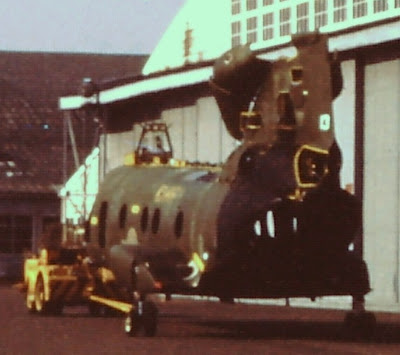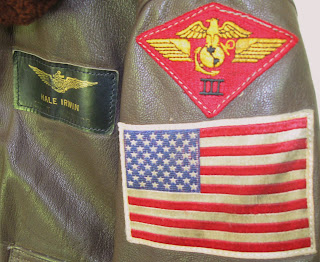After serving with the Fuji Detachment in Japan I returned to H&MS-36 in Okinawa. Here my primary duty was as a PMIP (Post Maintenance Inspection Pilot) on CH-46s. Every time maintenance is done on an aircraft a PMIP must flight test the bird and sign it off before it can be assigned back to the regular flight schedule.
We also received damaged and tired aircraft from the combat zone in Vietnam. These aircraft were shipped to Okinawa on barges and rolled off on a beach about 15 minutes flight time from our base at Futema. These birds had all the windows broken out of them so the grunts could shoot out of them. Heaters had been removed to get rid of extra weight All the birds were covered with lots of little tin patches on the fuselage covering holes made by AK-47s, shrapnel and other such harmful devices! Rice was found beneath the floor panels among other things revealing the rough history of these birds and the Marines that had flown in them. We held our breath, prayed, and flew these aircraft to Futema hoping the fuel gauges worked and the engines would run for the required 20-30 minutes! I recall one time flaming out one of the two engines as we taxied off the runway to our flight line due to faulty fuel gauges.Over the next weeks the aircraft were checked over as best they could be to prepare them for a five hour over-water flight to the southern tip of Japan. As a test pilot I lead at least three two-bird flights from Okinawa to Atsugi Japan where they would undergo major overhaul. We would then fly repaired helicopters back to Okinawa. We worked very closely with the weather-guessers to choose a day where the winds would be favorable. We joked that the weather prognosticators could not even predict rain if they looked out the window and saw it raining. However, they gave us very detailed wind estimates for various altitudes. It was the command pilot's decision when to go. The flights were done by dead-reckoning (SWAG) because at our low altitude we could pick up no navigational aids. The aircraft were loaded with two huge auxiliary internal fuel tanks that, with luck and good winds, would provide us adequate fuel to reach a Japanese base at the Southern tip of Japan.
 |
| CH-46 Loaded with Fuel Tanks for Flight to Japan - Hope we got enough! |
One time we landed with less than 15 minutes fuel remaining! The tough part of these flights was we could not smoke with the internal tanks on board and we were COLD - flying in the winter with no heat, missing windows wearing summer flight suits!
After a layover at MCAS Iwakuni, we topped off our tanks and flew East - turning North around Mt Fuji to land at Atsugi about 10 miles inland from Yokohama. We turned over the aircraft to NIPPI, the Japanese Contractor doing heavy overhaul work for FAWPRA: Fleet Air Wing Pacific Rework Activity.
After "cheating death" on at least 3 of these round trips I was transferred to Atsugi to be a test pilot working with NIPPI (Nippon Aircraft Corporation) as they overhauled Marine and Navy aircraft. This was an exciting job working with the Japanese mechanics testing the helicopters after they underwent total tear down and rebuild. These people did outstanding work. After a month an aircraft that looked like it should be headed to a junk yard rolled out of the factory looking brand new.
 |
| No - not headed to the junk yard |
Our responsibility was to flight test them and make sure they flew like new! My sign-off was the official acceptance of the aircraft back to to the Marine Corps. It was an awesome responsibility and I made every effort to be sure everything was perfect because the lives of others would be held in the balance for years to come.
A month after leaving Atsugi and returning to the States I was shocked to hear about a horrible crash in one of the birds I had tested. The aircraft was air taxiing at Yokota Air Force base after picking up passengers. As it hover taxied in front of a Transport Airplane the CH-46 suddenly came apart, and self destructed in mid air, killing all on board. Evidently, a part in the rear transmission was installed improperly, the transmission seized, the rotors inter-meshed and that was all she wrote. Unfortunately this was something no amount of test flying could reveal.
 |
| The author with two Nippi Mechanics on Flight Line at Atsugi |
 |
| Nippi Flight Line Mechanics Removing and Engine |
*************************
Little did I know that my next year at MCAS Cherry Point, North Carolina would be the exact opposite as I learned to fly the standard grey GI Mark One, Mod.2 desk..... I was pushing paper!
I did not like it
A year of administrative work prompted me to write my detailer at Headquarters Marine Corps and ask for an "early out". I asked to leave the Marine Corps early before my regular 3 years would be up!
Stay tuned - the best was yet to come.


No comments:
Post a Comment